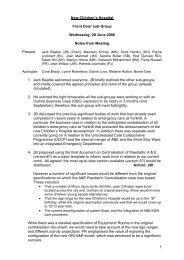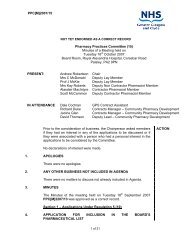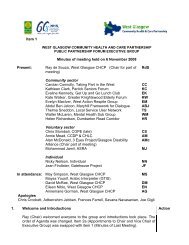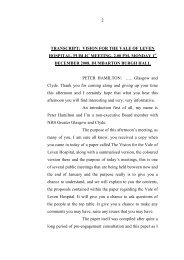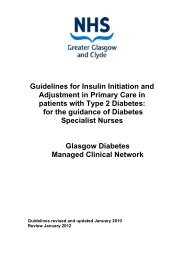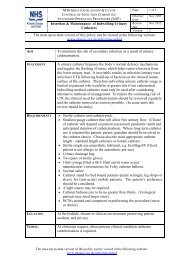Whiplash Neck Sprain
Whiplash Neck Sprain
Whiplash Neck Sprain
Create successful ePaper yourself
Turn your PDF publications into a flip-book with our unique Google optimized e-Paper software.
What are the treatments for a whiplash neck sprain?<br />
Exercise your neck and keep active<br />
Aim to keep your neck moving as normally as possible. At first the pain may be bad, and<br />
you may need to rest the neck for a day or so. However, gently exercise the neck as soon<br />
as you are able. You should not let it 'stiffen up'. Gradually try to increase the range of neck<br />
movements. Every few hours gently move the neck in each direction. Do this several times<br />
a day. As far as possible, continue with normal activities. You will not cause damage to your<br />
neck by moving it.<br />
Medicines<br />
Painkillers are often helpful and may be recommended by your doctor.<br />
Paracetamol at full strength is often sufficient. For an adult this is two 500 mg<br />
tablets, four times a day.<br />
Anti-inflammatory painkillers. These may be used alone or at the same time as<br />
paracetamol. They include ibuprofen which you can buy at pharmacies or get on<br />
prescription. Other types such as diclofenac or naproxen need a prescription. Some<br />
people with stomach ulcers, asthma, high blood pressure, kidney failure, or heart<br />
failure may not be able to take anti-inflammatory painkillers.<br />
A stronger painkiller such as codeine is an option if anti-inflammatories do not suit<br />
or do not work well. Codeine is often taken in addition to paracetamol.<br />
A muscle relaxant such as diazepam is occasionally prescribed for a few days if<br />
your neck muscles become very tense and make the pain worse.<br />
Other treatments<br />
Some other treatments which may be advised include:<br />
A good posture may help. Check that your sitting position at work or at the<br />
computer is not poor. (That is, not with your head flexed forward with a stooped<br />
back.) Sit upright. Yoga, pilates, and the Alexander technique all improve neck<br />
posture, but their value in treating neck pain is uncertain.<br />
A firm supporting pillow seems to help some people when sleeping. Try not to use<br />
more than one pillow.<br />
Physiotherapy. Various treatments may be advised by a physiotherapist if the pain<br />
is not settling. These include traction, heat, manipulation, etc. However, what is often<br />
most helpful is the advice a physiotherapist can give on exercises to do at home. A<br />
common situation is for a doctor to advise on painkillers and gentle neck exercises. If<br />
symptoms do not begin to settle over a week or so, you may then be referred to a<br />
physiotherapist to help with pain relief and for advice on specific neck exercises.<br />
Treatment may vary and you should go back to see a doctor:<br />
If the pain becomes worse.<br />
If the pain persists beyond 4-6 weeks.<br />
If other symptoms develop such as loss of feeling (numbness), weakness, or<br />
persistent pins and needles in part of an arm or hand. These may indicate irritation to<br />
or pressure on a nerve emerging from the spinal cord.<br />
Other pain-relieving techniques may be tried if the pain becomes chronic (persistent).<br />
Chronic neck pain is also sometimes associated with anxiety and depression which may<br />
also need to be treated.<br />
What is the outlook (prognosis) after a whiplash neck sprain?<br />
Page 2 of 3<br />
This will depend on the severity of the sprain, but the outlook is good in most cases.<br />
Symptoms often begin to improve after a few days. Most people make a full recovery within<br />
a few weeks. However, in a small number of people, some symptoms persist long-term.





